Welcome to the order of operations worksheets page at Math-Drills.com where we definitely follow orders! This page includes Order of Operations worksheets using whole numbers, integers, decimals and fractions.
Elementary and middle school students generally use the acronyms PEMDAS or BEDMAS to help them remember the order in which they complete multi-operation questions. The 'P' or 'B' in the acronym stands for parentheses or brackets. All operations within parentheses get completed first. The 'E' refers to exponents; all exponents are calculated after the parentheses. The 'M' and 'D' are interchangeable as one completes the multiplication and division in the order that they appear from left to right. The fourth and final step is to solve for the addition and subtraction in the order that they appear from left to right.
More recently, students are being taught the acronym, PEMA, for order of operations, to avoid the confusion inherent in the other acronyms. For example, in PEMDAS, multiplication comes before division which some people incorrectly assumes means that multiplication must be done before division in an order of operations question. In fact, the two operations are completed in the order that they occur from left to right in the question. This is recognized in PEMA which more correctly shows that there are four levels to complete in an order of operations question.
Unless you want your students doing something different than the rest of the world, it would be a good idea to get them to understand these rules. There is no discovery or exploration needed here. These are rules that need to be learned and practiced and have been accepted as the standard approach to solving any multi-step mathematics problem.
Most Popular Order of Operations Worksheets this Week
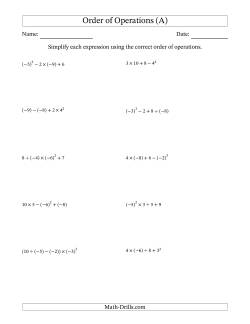
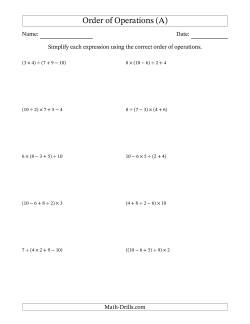



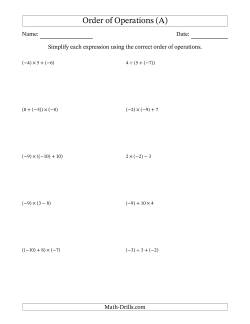
Order of Operations With Whole Numbers and Integers
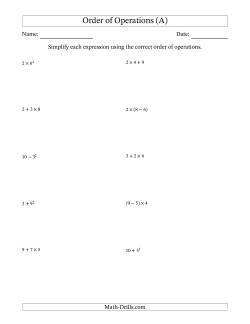
The worksheets in this section include questions with parentheses, addition, and multiplication. Exponents, subtraction, and division are excluded. The purpose of excluding some parts of PEMDAS is to ease students into how the order of operations works. To help students see a purpose for the order of operations, try to associate the expressions with related scenarios. For example, 2 + 7 × 3 could refer to the number of days in two days and three weeks. (9 + 2) × 15 could mean the total amount earned if someone worked 9 hours yesterday and 2 hours today for $15 an hour.
Order of Operations With Whole Numbers (Addition and Multiplication Only)
The worksheets in this section include questions with parentheses, addition, subtraction, and multiplication. Exponents and division are excluded. This section is similar to the previous one in that it is meant to help ease students into the order of operations without complicating things with exponents and division.
Order of Operations With Whole Numbers (Addition, Subtraction and Multiplication Only)
One last section to help ease students into the order of operations or simply for students who haven't learned about exponents yet. The questions on the worksheets in this section include parentheses and all four operations.
Order of Operations With Whole Numbers (No Exponents)
The worksheets in this section include questions with parentheses, exponents and all four operations.
Order of Operations With Whole Numbers (All Operations, Parentheses and Exponents)
Order of Operations With Integers (No Exponents)
The worksheets in this section include parentheses, exponents, and all four operations.
Order of Operations With Integers (All Operations, Parentheses and Exponents)
Order of Operations With Fractions and Decimals
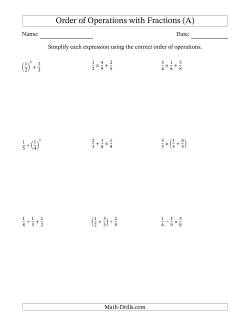
As with other order of operation worksheets, the fractions order of operations worksheets require some prerequisite knowledge. If your students struggle with these questions, it probably has more to do with their ability to work with fractions than the questions themselves. Observe closely and try to pin point exactly what prerequisite knowledge is missing then spend some time going over those concepts/skills before proceeding. Otherwise, the worksheets below should have fairly straight-forward answers and shouldn't result in too much hair loss.
